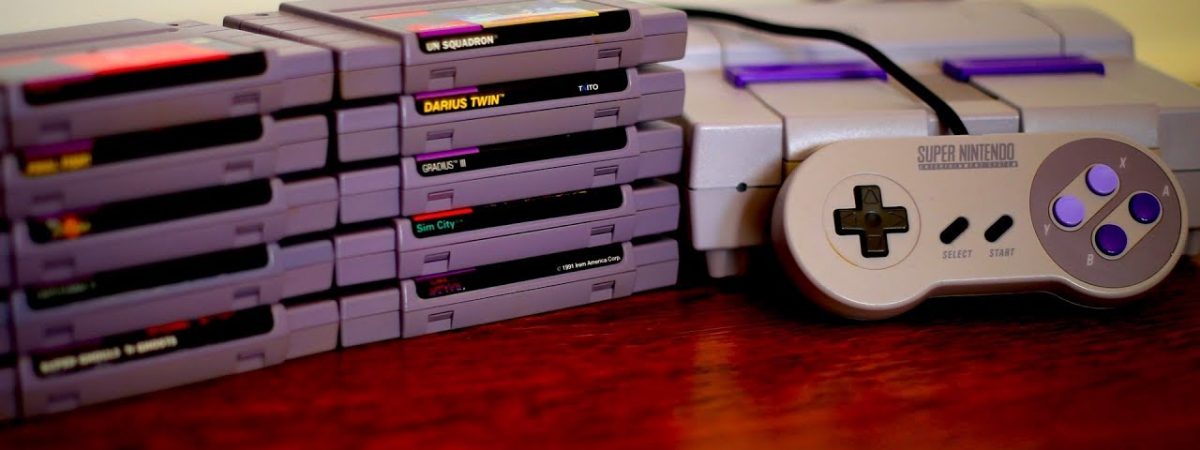
The Super Nintendo Entertainment System, or SNES for short, is arguably one of the best consoles ever released. To this day it has remained a cornerstone of gaming for well over two decades, living on through emulation (despite Nintendo’s persistent fight against ROM sites) and most recently Nintendo’s own Virtual Console releases and SNES Mini plug-n-play console. It not only carried on classic franchises from the 8-bit NES era, such as Metroid, Zelda and Super Mario, but improved upon these classic games in ways that cemented their status in pop culture forever. It even gave birth to new franchises such as Star Fox and F-Zero, that still live on today in some form.
Personally the SNES was part of my introduction into the world of video games. In addition to playing classic DOS games on my dad’s PC, the SNES was my mother’s foray into video gaming and one of the perks of growing up with separated parents was that I got exposed to both things at once. I would play DOS games while at my father’s place and while at home the SNES was my go-to source of interactive electronic entertainment.
So as a nostalgic celebration of this legendary console, I will be listing my personal top 10 games for the SNES. Keep in mind that if your favorite game is not on this list, it does not in any way mean that game is bad, it simply means the game is not one of my favorites. The SNES has one of the best game libraries in the world and with so many great titles to choose from, no matter what you do a lot is going to be left out. So without further ado, let’s get to the meat. Here are my top 10 best SNES games of all time.
10 X-ZONE
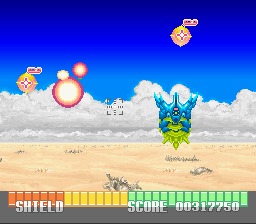
If you own a Super Scope, and have grown tired of the pack-in “Super Scope 6” cartridge, I highly recommend giving X-Zone from Kemco a try. At heart it’s pretty much a straight up light gun railshooter, where the entire goal is to make it to the end of the game in one piece.
A unique feature of the game is that it uses the Super Scope’s cursor button to display a cursor on screen as opposed to using the Super Scope’s actual scope. This means you don’t necessarily need to hold the Super Scope on your shoulder, but can hold it more like a rifle and aim with the on-screen cursor. The on-screen cursor is necessary in either case for firing your secondary weapon. A key feature of the game is that you can target enemies’ weakpoints and fire missiles at them when you let go of the fire button. Mastering this game mechanic is pretty much key to winning the game on Hard mode, which is what you need to do in order to get the best ending.
The game sports some pretty impressive graphics for the console, with an airdiving stage opening the game and utilizing the SNES’ great Mode 7 graphics to an impressive effect, similar to Pilotwings. It also features a pretty rocking soundtrack. If anything is holding it back in particular I would say it’s a bit short, but being more of an arcade game, it can be forgiven and is pretty fun to play through once in a while.
What I like the most about the game is that while playing it I sort of go into a trance-like zen state of just killing everything on screen, and it feels strangely satisfying. The game throws a constant barrage of enemies at you, with your survival dependent on how quickly you can shoot everything flying at you before it hits you and takes away precious shield energy. Enemies will drop frequent P symbols though, which you can shoot to recharge your shield a bit.
9 THE MAGICAL QUEST STARRING MICKEY MOUSE
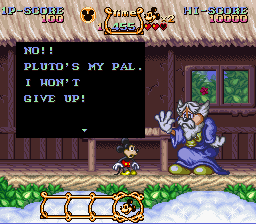
Disney was an absolutely massive part of my childhood. As a child of the 90’s I grew up right in the middle of the Disney renaissance, with great movie after great movie coming out and the Disney TV shows airing on Saturday mornings. So it goes without saying there was a fair bit of Disney on the video game market as well. Capcom was mostly in charge of these games, as they had been during the 8bit era as well, and their pedigree for quality was practically unmatched at the time. Disney chose their developers wisely during this era and it shows.
There are a ton of great Disney games on the SNES, with movie tie-ins such as Aladdin and The Lion King being particularly memorable. But one of the Disney games that I played the most growing up was The Magical Quest, starring the one and only Mickey Mouse.
The premise of the game is that Pluto has been taken by the evil emperor Pete to his castle, and Mickey must go to rescue him. He’s not alone however, and aided by a magician and his trusty friends Goofy and Donald, Mickey soon gains an arsenal of costumes that give him different abilities to overcome the challenges ahead of him.
The game features a lot of different gameplay elements that keeps it constantly fresh and challenging. It’s not a massive game and can be completed in one sitting, but it has some of the best music, graphics and level design of its era and all with the distinct Capcom style that their games had during this era.
The game doesn’t really follow any specific Disney IP but it feels very inspired by the short films with Mickey and Pete, and feels more like its own original story, which I like since it puts it on its own compared to tie-in games. I definitely recommend giving it a try if you’re a Disney fan like me and need something to play that’s a bit different than Aladdin or The Lion King.
8 STAR FOX
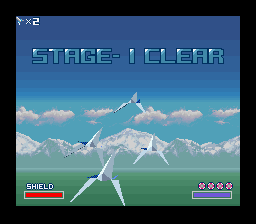
During the SNES era, most games on the console were 2D and while the SNES was capable of delivering pseudo-3D effects such as Mode 7 which was used to great effect in games like F-Zero, Pilotwings, Super Mario Kart and the SNES port of Doom, it was widely believed that true real-time 3D rendering was impossible on the console. That’s until the folks at Argonaut came up with a brilliant idea. The idea was to instead of relying on the SNES’ CPU to do the 3D, they would create a specialized co-processor that would do the actual 3D graphics, essentially making the Super FX chip the first industry standard GPU. It allowed the creation of what initially started as a tech demo for this new chip, Star Fox.
Star Fox eventually grew into a game of its own, utilizing the Super FX chip to create graphics that up until this point had never been seen on the SNES, using shaded polygons to create 3D shapes that would make up the game’s world and creatures. It achieved this while maintaining a mostly acceptable framerate and the game itself is a pretty good game all things considered and not just a tech demo.
It follows the exploits of the Star Fox crew, a team of ace pilots consisting of Fox McCloud (the main character), Falco Lombardi, Peppy Hare and Slippy Toad, lead by general Pepper. All of the characters are anthropomorphic animals who speak in a sort of gibberish language due to the SNES’ limited audio capabilities (although the game does feature actual speech samples at several points). The game is a straight up rail shooter, where you go through levels while avoiding obstacles, shoot enemies and do your best to stay alive until you face the level boss and head on to the next level, until you reach the final boss, Andross.
Back in the day, whenever I wanted to show off what the SNES could do, this was always the game I would show to friends, rather proudly as I didn’t have any more advanced consoles at the time. To this day I am still amazed by what this game pulled off on a console that shouldn’t be able to do what it did, and the Star Fox series is now one of my favorite Nintendo franchises, and possibly a major reason why I later became a part of the furry fandom (I also blame Sonic SatAm for this).
7 SUPER MARIO KART
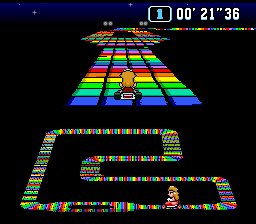
Before 1993’s Star Fox amazed us with its true 3D rendering wizardry thanks to its Super FX chip, there were a few other games that equally impressed gamers with more pseudo-3D effects. Mode 7 was a central part of several SNES titles, most notably F-Zero, Pilotwings and this one, which is the one I’ve played the most and have the strongest personal relationship with.
It was a game my mother picked up on a road trip, and it quickly became one of the most played games on our console, thanks in large part due to the fact we didn’t really have any racing games on it. I spent so much time with this game that I eventually beat it on the 150cc mode, a feat I remain somewhat proud of to this day and even playing it for this list, I managed to beat the 100cc mode easily. That is until I got to the special cup and its expert-level tracks that I felt a bit too rusty to deal with. At least I got a sweet screenshot from the first Rainbow Road track in the series in all its Mode 7 glory.
If you have never played Mario Kart, or only recently got into it, then this is probably a good game to check out since it was the very beginning of the franchise. As such it has very different gameplay compared to later titles, but several fun multiplayer modes, and a lot of unique elements that would never show up in the series for a long time, such as the feather powerup and gathering coins. In my opinion it remains extremely playable today, and is probably the most accessible racing game on the SNES.
6 TERRANIGMA
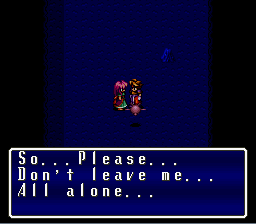
The SNES is probably one of the best consoles for the RPG genre, with games such as Chrono Trigger and Final Fantasy VI being some of the biggest classics on the console that remain widely enjoyed today. My personal favorite action RPG on the SNES however is a little game called Terranigma. It shares similar themes to a couple other games, Soul Blazer and Illusion Of Gaia. All of these games were developed by the same team, Quintet, and are widely considered part of a spiritual trilogy.
That being said, if you are going to play one of these games I highly recommend Terranigma as it is the one that has grabbed my attention the most. It’s arguably one of the biggest and deepest games on the SNES, with an epic story that spans space and time and history itself, telling an alternate Earth history unlike any I’ve experienced before. You play as Ark, a young boy and a bit of a troublemaker who lives in the underworld, one day finds a box hidden away in his Elder’s basement. Upon opening the box, he sets in motion the awakening of the surface world, which at this point is an uninhabitable wasteland.
The story is told extremely well through its dialogue and grabbed me unlike most games of this era ever has. The game has some of the best music and visuals of its era, using sometimes digitized real photographs for its artwork. It’s honestly one of the most engrossing games I’ve ever played and while I have yet to beat it, I can honestly say it’s one of my favorite games on the SNES and if you’re at all a fan of 16-bit action RPG’s, then please give this game a try. I can promise you won’t regret it. Sadly the game was never released in the US, only Japan and Europe, so finding a copy might be a bit difficult if you live in the US, but no matter how you choose to play it, it’s worth playing for sure.
5 WARIO’S WOODS
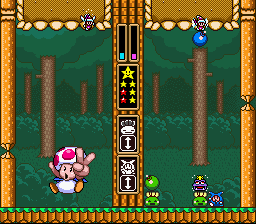
Growing up, Wario’s Woods was my mother’s game of choice, which is understandable given her taste in gaming has always been on the casual side (she’s pretty much exclusively a mobile gamer nowadays) which is a massive difference from myself. But this game is something both she and I enjoyed immensely growing up, and one we’ve both gotten really good at.
It’s basically a puzzle game where you have to match 3 or more monsters of the same color then use a bomb of the same color to blow them up until all the monsters are destroyed, while trying to keep a massive Thwomp from crushing you as it moves lower and lower the more monsters are on the level. Some monsters will require special tricks to destroy such as non-standard patterns or destroying twice. While you’re playing, two different creatures will be shown on top of the screen. A fairy and some kind of insect (a fly maybe). The fairy will spawn bombs for you to use but the fly will spawn more monsters to destroy. In the “Round Game” mode, the fairy belongs to Birdo who cheers you on, while the fly belongs to Wario who kind of just wants to screw your day over.
The game features several modes, both for multiplayer and single player.
The “VS Com” mode where you have to clear your screen before the computer opponent does. You face increasingly difficult levels and increasingly skilled players until you eventually face off with Wario himself, who serves as the final opponent, after which you beat the game.
The “VS 2P” mode is similar to “VS Com” except you play against a human opponent, choosing a skill level, amount of monsters and so forth before seeing who can clear their screen first.
The “Round Game” is a mode where you finish increasingly difficult levels with nothing to worry about save for screwing it up.
“Time Race” is a mode where you simply try to finish levels as fast as possible, and get graded based on how fast you are.
Finally there’s a “Lesson” mode where you can learn the game’s mechanics through different challenges which is great to introduce beginners to the game.
If you’re a fan of classic puzzle games such as Tetris and Dr. Mario, definitely give Wario’s Woods a try. I can’t tell you how many hours I have spent playing it but it’s incredibly addictive. Unfortunately I haven’t seen the SNES version on the Virtual Console, only the NES version, which I find strange as it is inferior to the SNES version in every way, but has the distinction of being the last official NES game ever released, for whatever it’s worth.
4 TMNT IV – TURTLES IN TIME
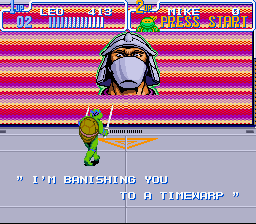
It’s probably as difficult imagining the early 90’s without the Teenage Mutant Ninja Turtles as it is imagining the 80’s without Duran Duran. They were pop culture icons, omnipresent in our collective youth to the point where I don’t think anyone I knew hadn’t either watched the animated series, bought the toys or played the games. And TMNT IV is probably the one we all played the most, not just among my friends but in general.
To this day it remains one of the best arcade ports ever, to the point where it even surpassed it, adding new mechanics, new stages and being just all around a superior experience. This was the era that to a lot of gamers cemented Konami as one of the best developers of their era, with titles like this, TMNT Tournament Fighters and Super Castlevania IV. And I probably don’t need to go into what Konami is to gamers nowadays…
Regardless, if you’re looking for a fun 2 player co-op brawler, you really REALLY can’t go wrong with TMNT IV. It features some of the best music on the SNES, some of the most fun gameplay, the best stages and of course, some of the most iconic characters of its decade. It’s not without reason this game has remained a popular cult classic, to the point it received a rather disappointing remake not too long ago. So instead of playing that, just grab some pizza, a friend or two and pop this cartridge in for some good times. Cowabunga!
3 B.O.B.
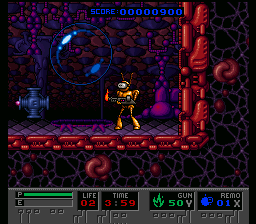
I will admit, I don’t think I’ve ever seen a top 10 list with this game and probably for a good reason. A lot of my love for this game is tied to my own nostalgia and memories of playing the absolute crap out of this game back in the day.
Before the days of the internet and access to pretty much every game ever made for a system, you were often stuck with what you had, and you’d get good at what you had because it was all you had. B.O.B. is such a game for me. It was included with the system my mother bought and of course, having already played Duke Nukem on my dad’s DOS PC, I really fell for its sci-fi aesthetic and run’n’gun gameplay.
Story-wise the game is dead simple and almost hilarious in how arbitrary it feels. It’s about a teenage robot going on a date. He takes his dad’s car, crashes on an alien planet, has to make his way to find another ride using an arsenal of powerful weapons and gadgets he picks up on the way, and that’s the entire setup for the game. I swear I’m not making it up. And the story has practically no impact on the gameplay itself, it’s just an excuse for the character to do this stuff. Though I find it hilarious that this character is doing mass genocide of alien creatures in order to go on a date with another robot. Can robots procreate? Is this turning into Blade Runner? Eh, let’s just not read too deeply into this…
2 SUPER MARIO ALL-STARS
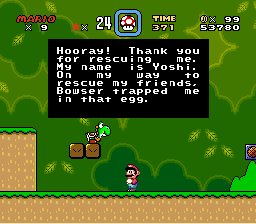
The concept of HD remakes is pretty common today but the concept itself is hardly new to gaming as a whole. Already back in the early 90’s, Nintendo released probably the most famous example of an early HD remake, Super Mario All-Stars, a 16-bit collection of the first 3 Super Mario Bros. titles, including both the international and Japan versions of Super Mario Bros. 2, all remade with 16 bit graphics and sound. Later copies even included the 4th game, Super Mario World, making it one of the most substantial game packages of its time.
It’s probably needless to say how big Mario was at the time. He was practically the face of console gaming itself, having saved the US from a home console video game crash in the 80’s. And all of his titles are some of the most solid platformers ever released. The Mario games have a unique quality to them, an almost kinetic connection with your controller and Mario on the screen. Super Mario World in particular is the game I probably played the most growing up, and to this day it remains my absolute favorite in the franchise. But in my opinion all 4 of these games are absolute classics that everyone should play at some point.
1 SUPER METROID
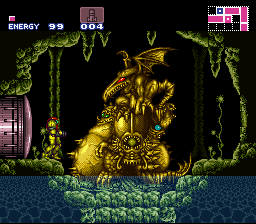
My first experience playing Super Metroid was ironically not growing up. It came much later, when I was in my teens and had just started getting into emulation and exploring games that I had never had the chance to play growing up. And Super Metroid became the strongest experience I had coming from this time in my life.
The only enduring image I had of Super Metroid was from an ad poster that came with one of our games growing up, and it was the image above, the statue of the four bosses. This image evoked a lot in me when I looked at it, most of all it envoked a deep curiousity. What type of game was this, who were these creatures, what was it about? All of these questions became answered much later when I finally sat down to play Super Metroid after a decade of waiting.
I had probably never felt so deeply engrossed in a 16 bit game before. I mean, sure, I had played the crap out of other SNES games before this, but Metroid was something else.
The atmosphere. The story that was told exclusively through visual cues, without a single word of dialogue. The amazing soundtrack filled with industrial sounds and haunting melodies. Foreboding levels that seemed daunting yet inviting. The unforgettable boss fights that had all kinds of hidden strategies in them.
And that moment when you’re about to die at the hands of Mother Brain, when the titular Super Metroid sacrifices its life to save you… All of this added up to make what in my eyes is the best Super Nintendo game ever made.
I’ve played a lot of SNES games, but none feel as complete, cohesive and all around solid as Super Metroid does. It feels purposeful, like nothing is wasted. It creates such a massive vast world within itself that feels alive and real despite using only 2D art and 16 bit sound. It’s a testament to how a strong vision can often be more important than hardware, when the vision dictates the hardware and uses it to its absolute fullest potential. It didn’t rely on a Super FX chip, it didn’t rely on Mode 7. It was all done in 2D with the SNES’ best strengths in mind. It shows off what was really possible on the system, and for that, I consider it the best.
